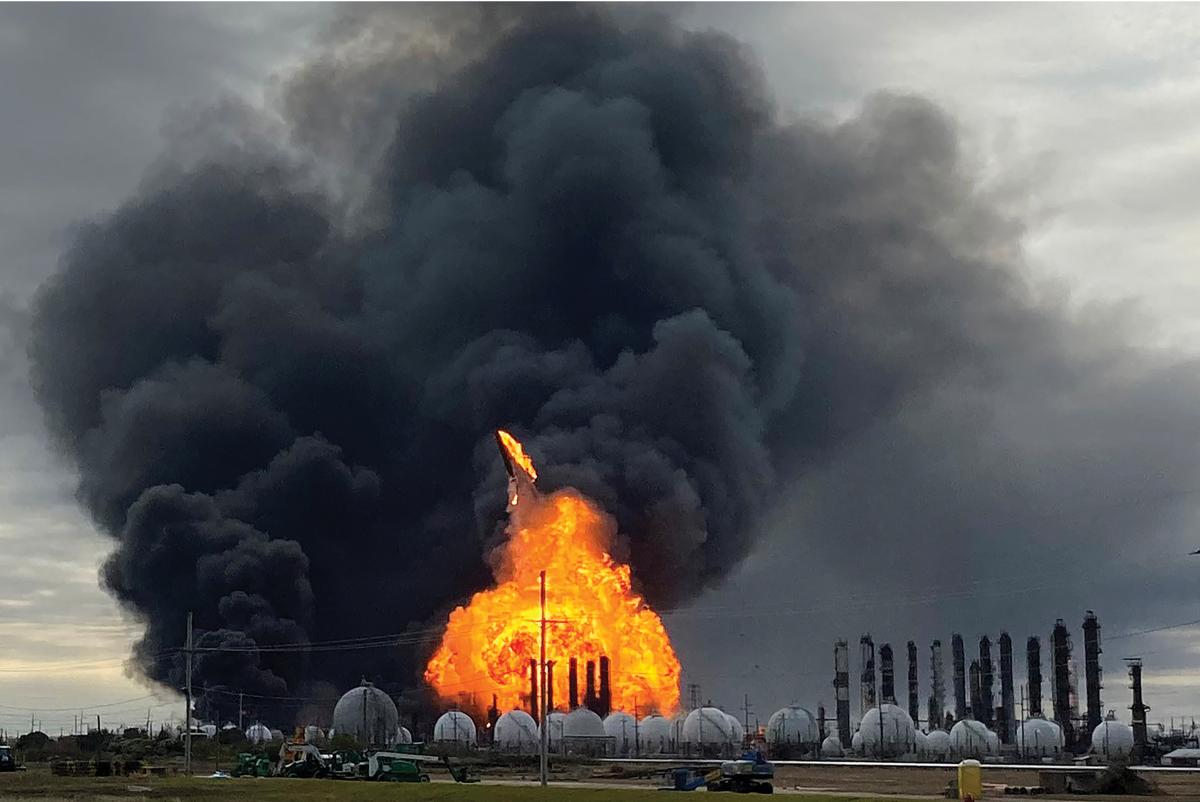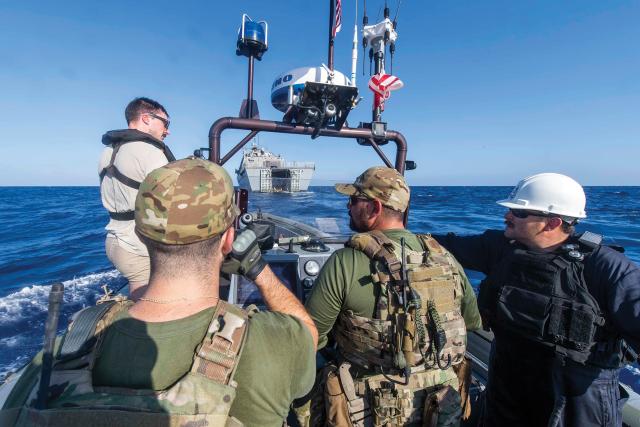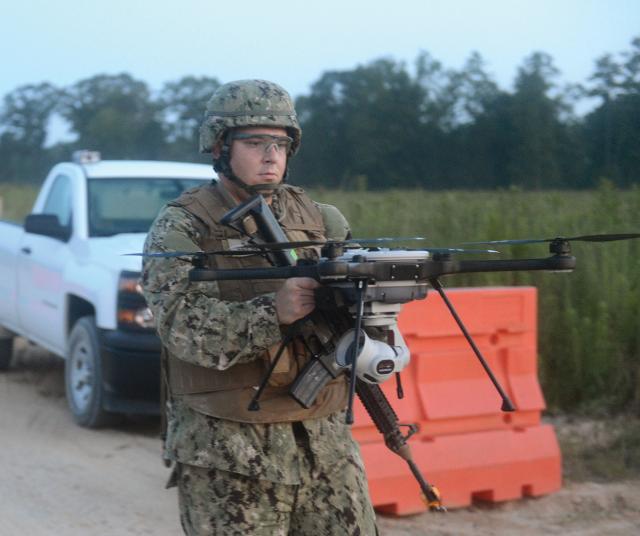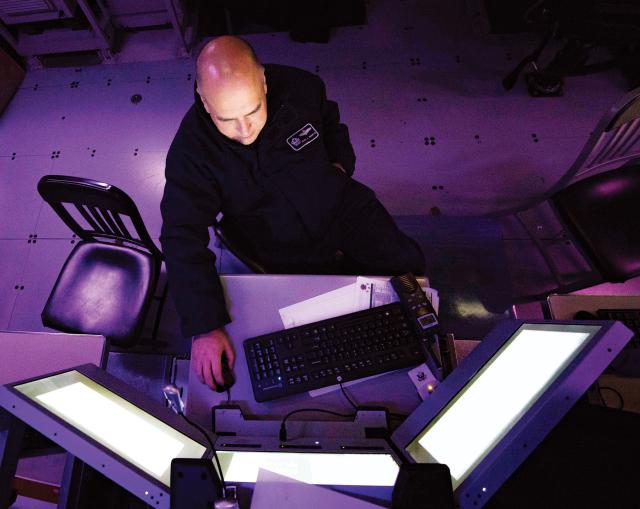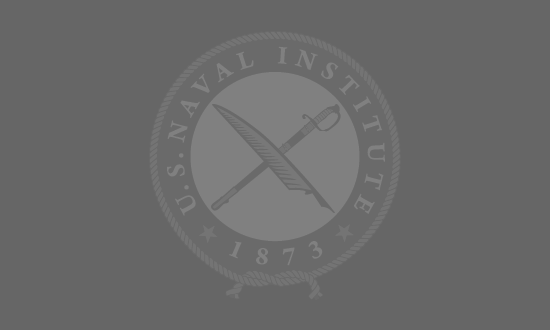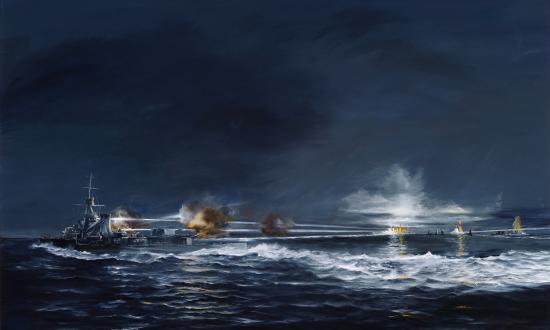Imagine a scenario in the not-too-distant future. Amir prepares to launch a swarm of drones from his special-purpose shipping container resting atop a neat stack of containers on an unflagged commercial vessel. The ship had been purchased through a shell company associated with the smuggling operations of a transnational criminal organization. After a careful transit through the strait and quiet passage toward the gulf, Amir’s A-hour had finally come. It had been more than two years since he left the University of Tehran, where he majored in mechanical and aeronautical engineering. Despite perfect grades and original research in leveraging additive manufacturing for unmanned aerial vehicles customization, Amir left school after becoming radicalized by internet propaganda supporting the Houthi struggle in Yemen against the Saudi-led coalition.
Now Amir’s swarm of Qasef drones are targeting the pipeline network carrying oil from the world’s most prolific oil field. Each of the 40 medium-range drones carries a shaped-charge explosive capable of penetrating the thickest commercial pipe wall. However, Amir’s mission is not in the Persian Gulf. Instead, Amir has traveled through the Florida Strait to the Gulf of Mexico, and his target is the Texas petroleum pipeline network. He watches anxiously as each autonomously piloted drone finds its target along the oil, gas, and refinery network of Port Arthur, Texas.
The Fight Is Coming Closer
The scenario above is not far-fetched. Commercial drone technology gives nonstate actors, such as the fictional Amir, the ability to target the U.S. homeland without crossing the border. Former Navy SEAL and current Congressman Dan Crenshaw (R-Texas) succinctly described U.S. military involvement abroad: “We go there so they don’t come here.” This is, in one sentence, the rationale for nearly two decades of U.S. operations overseas and the expeditionary nature of the U.S. national security enterprise.
For more than two centuries, the United States has enjoyed the benefit of two ocean-sized moats. As long as the military could keep adversaries on the far sides of the Atlantic and Pacific Oceans, life and business could remain relatively secure. In prior decades, an attack on the U.S. homeland required the resources of a nation-state or well-funded terrorist group. Today, less capable nonstate actors or proxy groups with minimal funding can launch commercially available drones from civilian ships or pleasure craft and hold the U.S. coastline at risk. The national security enterprise, with its robust intelligence network, has accumulated decades of experience countering these asymmetric threats far from home, but the proliferation of commercial drone technology has shifted recent thinking toward scenarios closer to home.\
Anticipating an asymmetric attack against the homeland seems daunting, but former Chief of Naval Operations Admiral John Richardson’s Design for Maintaining Maritime Superiority (version 2.0) provides the framework for the Navy information warfare (IW) community to prepare for such challenges. Maintaining maritime superiority near the homeland will require strengthening naval power, implementing high-velocity methods for intelligence sharing, adequately preparing Navy personnel, expanding the network of partners, and reinforcing intelligence and IW competencies—critical enablers in all four of the Design’s lines of effort. In embracing these, the IW community will be prepared to synchronize the operations of the Department of Defense (DoD), domestic security agencies, and civilian commercial entities to ensure continued security and economic prosperity.
Strengthening Naval Power
The Posse Comitatus Act of 1878 places significant limitations on domestic DoD activities. Other laws and executive orders further limit DoD and intelligence community (IC) domestic activities. Thanks to its ocean barriers, friendly neighbors, and the former limitations of enemy technology, the restrictions of U.S. law have not significantly prevented defense of the homeland. However, the recent escalations at the southern border highlight the resource and legal limitations of the Department of Homeland Security (DHS) as well as state and local governments. If malevolent actors equipped with commercially available drones choose to exploit these deficiencies, the Navy IW community will need to strengthen its role in defending the homeland.
The Navy’s distributed maritime operations (DMO) concept will be critical for strengthening naval power along the U.S. coastlines. The concept of operations for most large naval combatants involves projecting power far from the homeland, so in posturing for homeland defense, the Navy IW community will need to work with less familiar platforms, such as the light Coast Guard cutters and expeditionary hardware of the Marine Corps. For example, the Navy IW community can ensure better command-and-control (C2) interoperability by collaborating with the Coast Guard and Marine Corps in procuring common command, control, communications, computer, intelligence, surveillance, and reconnaissance equipment.
DMO requires commanding officers ready for mission command, meaning they are empowered to achieve a given objective with only general guidance. In homeland defense, Navy IW professionals must be prepared to operate in scenarios in which they align under Coast Guard C2, since that service possesses both national defense and domestic law enforcement legal authorities. In combining the legal authorities of the Coast Guard with the much larger resources of the Navy, the Sea Services will provide a more comprehensive and layered defense of the U.S. coastlines.
Implement High-Velocity Intelligence Sharing
Beyond the major effort of aligning personnel, platforms, and C2 with appropriate legal authorities, the IW community will need to design and implement a high-velocity operational architecture to support DMO. The priority will be to provide intelligence support to joint service planners and decision makers as well as federal, state, and local law enforcement partners. In addition, there will be a need to share indications and warning information with U.S. commercial and industrial entities for situational awareness. While measures will be necessary to protect intelligence sources and methods, the goal will be to distribute the greatest amount of useful intelligence at the lowest possible classification level. The National Geospatial-Intelligence Agency’s “Notice to Mariners” and the Federal Aviation Administration’s “Notice to Airmen” are models of how IW professionals can provide maximum support during operational planning and execution phases.
To excel at DMO with high-velocity methods, IW professionals must be practitioners of systems such as the plan, practice, perform, progress, and promulgate (P5) cycle. To aid commanders and units with this, the Sea Services must provide the tools and training necessary to make data-driven predictive decisions. The use of such science-based practices will lead to a virtuous cycle in the mission command environment, with higher quality data-driven decisions by unit leaders operating under mission command reinforcing trust in leaders performing DMO.
Navy personnel likely will be the best trained in P5 methods and provide the most capable maritime hardware but may lack the formal and informal relationships necessary to provide intelligence support to state and local organizations. Similarly, domestic institutions may lack mechanisms for providing input to IW professionals. The DHS National Response Framework (NRF) and National Incident Management System (NIMS) are excellent templates for integrating whole-of-government efforts for natural disasters and terrorist attacks. The Navy’s IW community should codify a plan to support the NRF and NIMS, and the Navy should recommend ways to better equip the NRF and NIMS for more complex defensive and offensive action.
Better Prepare IW Personnel
Since the most likely attack on the U.S. homeland will still come from a nonstate actor using an asymmetric tactic with commercially available technologies, IW personnel must be ready to integrate into a security environment close to home. The majority of active-duty military personnel are accustomed to operating exclusively within DoD C2 structures, but DoD personnel must be prepared to integrate into non-DoD chains of command to support civil authorities and joint domestic operations missions. In addition, qualified personnel must be prepared to support the intelligence planning process for domestic defensive and offensive cyber task forces.
Preparing personnel to support homeland operations can occur at relatively low financial cost, but it will require significant time to hone relevant skills. To facilitate the needed credentialing, active and reserve IW professionals must leverage block learning to receive ready and relevant training. DHS provides a significant library of pre-built NRF and NIMS training products for no cost, and the National Guard Bureau and U.S. Northern Command have many high-quality training products for supporting civil authorities. Conveniently, state and local governments as well as commercial entities already participate in the NRF and NIMS training programs. By using these standardized products, Navy personnel will become fluent in the language of domestic agencies and civilian commercial industry. As a result, IW units will be able to translate the joint intelligence process to domestic partners. Last, while the majority of Navy personnel belong to the active component, these civil-support and joint domestic operations missions provide an excellent opportunity to align the Navy Reserve to operational tasking instead of administrative roles.
Expand the Traditional Network of Partners
The Navy IW community also must reinforce relationships with military counterparts in the Army, Air Force, and the National Guard and reserve components. In addition to improving collaboration with joint partners, the Navy should identify useful spare capacity within DoD infrastructure to ensure agile, geographically mobile, and resilient intelligence support. At the service level, the Navy should consult with the Base Realignment and Closure Commission and refer to the Base Redevelopment and Realignment Manual on available spare capacity and methods for repurposing in the event of domestic mobilization.
The IW community is deeply integrated with the 17 members of the intelligence community. However, in defending the homeland, other federal agencies may possess valuable expertise and legal authorities, so collaboration will be paramount. For example, the intelligence community may rely on information from the Federal Aviation Administration to assess the threat posed by commercially available drones. And coordination over radio-spectrum allocation with the Federal Communications Commission and the National Telecommunications and Information Administration may be critical in disabling the communication methods of remote or autonomously piloted drones without jeopardizing commercial air traffic or cellular communications.
The Navy must deepen integration with state, local, and tribal authorities. The Naval Postgraduate School’s Center for Homeland Defense and Security is an excellent example of how the IW community can engage with local communities and industry to define potential demands, threat response, and information-sharing capabilities. Flexible memorandums of agreement (MOAs) must be negotiated now to best serve the homeland, before a crisis begins. In addition, the Navy must identify or create financial mechanisms that can rapidly fund the equipment active-duty members or mobilized reservists will need for unplanned scenarios.
Beyond national borders, naval intelligence and IW commands must codify principles of multinational intelligence sharing with foreign counterparts within the Western Hemisphere. Security cooperation and information sharing with Canada and Mexico will be the most critical. The Navy should identify ways to strengthen multinational exercises, such as PANAMAX (defense of Panama Canal), and create new exercises that will prepare combined intelligence support teams for multi-agency operations to defend the homeland. To support increased information sharing with the broadest number of partners, the Navy should consider using the U.S. Central Command’s “Middle East Stabilization Force” tetragraph as a model for sharing information with more partners. Finally, multinational intelligence and IW teams must provide threat assessments and vulnerability analyses for a range of cyber operations to protect critical infrastructure, such as transnational oil and gas pipelines, from drone attack.
In his book Team of Teams: New Rules of Engagement for a Complex World, retired Army General Stanley McChrystal recounted the reinvention of the joint special operations task force into an organization that could evolve as fast as the insurgent enemy in 2004 Iraq: “We had to tear down familiar organizational structures and rebuild them along completely different lines, swapping our sturdy architecture for organic fluidity, because it was the only way to confront a rising tide of complex threats.” McChrystal’s principles directly apply to the Navy IW community as the United States prepares for more threats at home.
The IW community must learn and adapt faster than U.S. adversaries to ensure maritime superiority in the approaches to the homeland. The Navy, other services, and domestic agencies are well staffed, equipped, and funded to prevail against emerging threats, but all parties must identify pathways to collaborate in the fastest and most efficient ways possible. Critically, this will require formal communication with civilian and commercial entities. Maintaining maritime superiority near the homeland will be an essential element for defending against the growing capabilities of asymmetric actors. By strengthening naval power, implementing high-velocity methods for intelligence sharing, adequately preparing personnel, and expanding the traditional network of partners, naval intelligence and IW teams will be prepared to ensure continued security and economic prosperity for the homeland.



